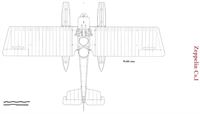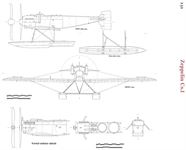O.Thetford, P.Gray German Aircraft of the First World War (Putnam)
Zeppelin-Lindau (Dornier) CS I
This experimental two-seat seaplane was built during 1918. It was of all-metal construction except for the fabric-covered wing and cruciform tail surfaces. Ailerons were fitted with Flettner-type servos. The machine was fitted with vee-type eight-cylinder Benz engine, and both nose and side radiator installations were tested. Engine, 195 h.p. Benz Bz IIIb. Span, 13.18 m. (43 ft. 2 7/8 in.). Area, 29.8 sq.m. (322 sq.ft.). Weights: Empty, 960 kg. (2,112 lb.). Loaded, 1,479 kg. (3,254 lb.). Speed, 150 km.hr. (93.75 m.p.h.). Armament, one Spandau and one Parabellum machine-guns.
Показать полностью
J.Herris German Seaplane Fighters of WWI (A Centennial Perspective on Great War Airplanes 2)
Zeppelin-Lindau (Dornier) Cs.I
Another serious competitor for two-seat floatplane fighter production was the Zeppelin-Lindau (Dornier) Cs.I monoplane powered by a 195 hp Benz V-8. This aircraft was also all metal except for fabric-covered wing and tail surfaces. The drag-producing box radiators mounted on the fuselage sides for testing undoubtedly resulted in lower speed than the design was potentially capable of, but were likely an expedient to speed up flight testing. The single Cs.I flown, Marine #8502, had not completed testing when the war ended.
Показать полностью
M.Schmeelke Zeppelin-Lindau Aircraft of WW1 (A Centennial Perspective on Great War Airplanes 42)
Zeppelin-Lindau Cs.I
Toward the end of 1917 the Reichs Naval Department decided to introduce metal-sea-fighting two-seater aircraft in the class C3MG (Double seat with two fixed and one movable MG). At the time the only companies able to deliver these kind of metal airplanes in the foreseeable future were Junkers and Zeppelin Werft Lindau. As a result, the RMA ordered three aircraft from each company.
On December 1st 1917, the order from the Reichs Naval Department arrived in Reutin. Three sea-fighter aircraft were to be delivered to Warnemunde by February 10th, 1918.
The order specifically asked that the Dornier C3MG be built primarily from duraluminum.
Further RMA demands for the Dornier C-aircraft were "good fighting characteristics", meaning, superior maneuverability and visual freedom for the crew. In addition, a flight endurance time of 3.5 hours, as well as good maritime capabilities, to withstand at least wind force 3 (which is about 6-8 meters per second). In horizontal flight the aircraft must be able to reach 170 kilometers per hour.
Strong climbing properties and maximum altitude were secondary, because the naval fighter aircraft usually operated at low altitude.
In the RMA order, it was explicitly stated that Dornier's metal designs would complete comparison testing with traditionally-constructed aircraft, in wood and fabric, such as the Brandenburg W29, at SVK. The three Cs.I aircraft received the RMA Naval numbers 8501-8503.
In December, Dornier and his designers immediately went to work in Reutin. The designs that resulted were given the company designations of 10351/51 to 10351/53. Zeppelin-Lindau (Dornier) gave the aircraft the official name Cs.I. The development work and partial construction took place in Reutin, the assembly and testing were done at the hangar in Seemoos.
The hull, the floats, and the vertical stabilizer were made completely of metal. The hull was once again built upon the principle of self-supported monocoque construction around a main frame and a sheet metal skin. The spars of the wings and the negatively-formed elevator were made of steel, and the rib construction was finished in duraluminum and covered with fabric. Due to advanced metal building techniques, the Cs.I was almost completely constructed without tension cables. Only the wings of the low-wing aircraft were attached to the fuselage with tension wires.
RMA designated the power plant to be the newly developed Benz V8-engine (Bz IIIb) with 195 horsepower. The Benz Bz IIIb was, as was usually the case at the time, mounted in the front of the Cs.I hull on two spars and without vibration shock absorption. The engines were cooled with two side radiators mounted on the sides of the fuselage.
Dornier solved the problem of the RMA's demand that the observer MG had to have a free field of fire over the head of the pilot with a Hussmann MG ring. The support bracket could be swung vertically as well, so that there was free motion above the pilot. The weapon for the observer was a newly developed MG from the company of Vorwerk & Co., Barmen. The MG was named after its developer, Karl Gast: Gast Machine Gun Model 1917. It was possible to fire 1,800 shots per minute. For the pilot, two stationary Spandau IMG 08/15 (firing rate 500/minute) were installed in front of his fuselage cutout.
The maiden flight of the first Cs.I (Navy number 8510) took place on Lake Constance on May 11th, 1918. Ober-Flugmeister Weiss was the pilot and Eugen Jager acted as observer. Only about five months had passed from receipt of the order to first flight. This was surely an impressive achievement even though Dornier and his developers had previously gathered a great deal of experience in building aircraft with metal.
Structural testing was carried out on the Cs.I 8501 in June 1918 as the official RMA construction authorities watched. The cell and the wings were weighted down with bags of sand or lead rather than air. Required were five times the total weight. So, each wing was weighted with times the total weight of 1425 kilograms. Cs.I passed the tests with flying colors. Normally, aircraft were loaded until they broke, in order to determine the maximum load. But in Seemoos the engineers decided not to overload the craft, that is up to the six-fold additional weight, because the Cs.I had to continue testing on Lake Constance until the end of June.
In July 1918, Dornier gave the Cs.I number 8502 aircraft to the naval SVK in Warnemunde. There is no explanation in the files about the delayed delivery date however it was likely due to engine and radiator problems.
The single visible difference from the 8501 were the trim tabs on the ailerons. On August 1st 1918, a first meeting to discuss the test results of Cs.I 8502 was held in Warnemunde. Participants included engineers and naval pilots of the SVK, as well as ZWL engineers Schulte-Frohlinde and Ober-Flugmeister Weiss.
The main complaints were around the aircraft's insufficient longitudinal stability. The probable reason for this was the elevator, and for the third aircraft, number 8503, this was to be improved with a larger horizontal stabilizer. In addition, the Benz Bz IIIb was considered not fully developed.
A further point of criticism of the Cs.I 8502 were the aerodynamically unfavorable side coolers. The SVK wanted to ascertain as to whether or not this was the reason for the insufficient longitudinal stability by attaching a dummy cooling system to a Brandenburger single-decker aircraft. But in Reutin, engineers had already recognized the radiator problem. In March 1918, Dornier suggested attaching a front radiator to the 8503. The RMA approved this modification on July 11th 1918, under the condition that it also used a Benz Bz IIIb with planetary gear.
In the meeting on August 1st between the SVK and Dornier, participants decided that the deficiencies on the 8501 and 8502 would be rectified, so that these aircraft could serve in a training role. In addition to the engines and the cooling system, the floats were enlarged, and the bow section of the floats would be flattened. The angle of the floats had been too steep. In addition, the rear float strut had to be relocated to higher up on the fuselage in order to avoid cutting the water. Since the changes in the three Cs.I basically amounted to developing a new airplane, Dornier suggested to the SVK a follow-up order of three further airplanes. These would be put to work at the bases close to the front. It is not likely that the RMA gave this new order.
All of the technical revamps were signed into a contract on October 25th, and construction of 8503 could continue. The aircraft was complete in mid-November 1918 and began operations on Lake Constance.
The end of the war in November 1918 prevented the 8501 and the 8502 from ever receiving their modernizations. On January 20th 1920, the mothballed Cs.I 8502 fell victim to a fire in Warnemunde. After the end of the war, Cs.I 8501 and 8503 were shelved in Lindau, and later in Seemoos. After 1920, all trace of the two aircraft is lost.
Hugo Junkers, too, was unable to bring his J11 metal aircraft to combat-ready maturity before the end of the war. Although his J11 were due to receive Daimler-Mercedes D IIIa engines with 160 horsepower, he also had to deal with development issues. The metal paneling, typical for Junkers aircraft, proved to be too soft and warped, especially around the engine area. In addition, the unpainted sheet metal was susceptible to sea-water corrosion and had to constantly be cleaned with an oil-soaked rag to remove rust. The biggest problem were the floats, which Junkers purchased from Luftfahrzeuggesellschaft Bitterfeld. The front tips broke off during the first landing. The entire structure of the floats was incorrectly manufactured and/or sealed. Alone for reasons of prestige, Junkers could not use the duraluminum floats from ZWL, which, beginning in 1917, were also sold to several other companies including Flugzeugbau Friedrichshafen.
Camouflage Livery of the Zeppelin-Lindau Cs.I
All of the aircraft purchased by the Navy had to comply with the camouflage paint scheme requirements outlined in the Bau und Liefervorschrift ("Construction and delivery regulations") of the RMA from January 1916. Exceptions were made only for test aircraft that were not intended for combat.
ZWL also followed these regulations. While painting the Rs.I and Rs.II, the craftsmen in Seemoos had more or less free rein during the construction period 1915-1916. The hulls and wings were painted grey-green. Only the national emblems, the iron crosses, were required on these aircraft.
The tail covering of the Rs.III received its tricolor hexagonal camouflage fabric once it arrived in Warnemunde.
On March 28th, 1917, the regulations were amended, so that the seaplanes were required to be painted as follows:
“[...] all areas visible from the top, so the top side of the wings, the fuselage, the floats, the attenuation surfaces, and the elevator will be painted in three dark colors, grey-blue, grey-brown, and grey-violet, in regular hexagons where each side will be 15 centimeters long [...]"
The fabric coverings of the lower side of the wings and elevator would remain in the natural color. For the top and sides, one used the industrially printed tri-color hexagonal camouflage fabric, which the industry produced according to the regulation called Besondere Bedingungen fur Seeflugzeuge (Special conditions for seaplanes). The undersides of the wings and the elevator remained in "linen-natural" color and were only painted with a clear protective seal to shield against seawater.
The fuselage and the floats were not painted, since paint would not stick to the shiny duraluminum with the natural oxide layer. SVK tests also determined that tar paint also dissolved. Therefore, the aircraft whose duraluminum floats were painted with a tar varnish were stored out of the sun at the bases, since the varnish would drip off after a short time. The floats were to have the camouflage fabric attached only to the tops. The impermeability of the ZWL floats was sufficient because of the felt strips between the rivets.
The duraluminum rudder of the Cs.I was simply painted white several times.
Specifications of Zeppelin-Lindau Aircraft
Type Length, m Span, m Height, m Chord, m Propeller Manufact. Armament
(guns) Weight, kg Motor Crew
Cs.I 8.88 13.28 3.04 2.50 Heine 2.75 2 fixed, 1 flex 950 Benz Bz IIIb 195 bp 2
Military Numbers of Dornier-ZWL Aircraft
Military Designation Manufact. Type Class Engine Notes
M.N.8501 ZWL (Do) Cs.I C3MG Bz mb 1 x Bz IIIbo / 1 x Bz IIIbm
M.N.8502 ZWL (Do) Cs.I C3MG Bz IIIb 1 x Bz IIIbo / 1 x Bz IIIb
M.N.8503 ZWL (Do) Cs.I C3MG Bz mb 1 x Bz IIIbo / 1 x Bz IIIb
Показать полностью


























